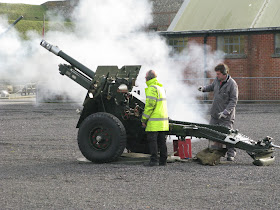Someone posted this photo on a Facebook page. It is of a "roulante", a large, horse-drawn, mobile cooker with a limber, full title Cuisine Roulante avec Avant-Train. The roulante was issued to all branches of the French Army and was designed to cook meals for a company of soldiers or the equivalent, approx 150 - 200 men.
I found some more photos.
There were a number of different manufacturers, each producing slightly different designs. Thousands were made and then taken into storage in 1919.
During the 1920's and 30's, one model was chosen and kept. In 1939, they were taken out of storage and 8822 were issued to regiments. Orders were issued for the manufacture of 440 new models per month, but this figure was never achieved.
In the early 30's, a roulante for motorised units was developed as a trailer. This was the Cuisine Roulante-Remorque mle 1916-1936 M.38. Around 3000 were available in September 1939, with orders for a total of 250 per month, not reached, were given to several manufacturers.
Friday, 28 December 2012
Tuesday, 25 December 2012
Saturday, 22 December 2012
Beau Geste
Robert Preston (Digby Geste), Gary Cooper (Beau Geste), Ray Milland (John Geste) from 1939 Hollywood film of "Beau Geste", with Ray Milland's signature across the photo.
Friday, 21 December 2012
280mm Mortier
Two more pictures of Schneider built 280mm mortars.
The top picture looks like a factory setting, or a training exercise. The second is a coloured photograph from 1914.
This picture is of 154 Regiment Artillerie Positional (RAP) taken at Christmas 1939, during the drole de guerre.
As I mentioned yesterday, these WW1 mortars were still in use in 1939/40. In June 1940, it was two batteries, each of two mortars, of 154 RAP that smashed Italian observation posts on the top of Chaberton.
Thursday, 20 December 2012
280mm Mortier
A Schneider 280mm Siege Mortar Model 1914/16 being loaded. This mortar fired a 205kgs shell to a maximum range of 10950metres. The location is unknown. The relatively short range would have placed the battery within easy range of larger German field pieces so sighting would have been paramount. This piece appears not to be camouflaged.
A number of 280mm mortars were still in use during the 1940 campaign, giving good service on the Italian front. They were captured and used by the Wehrmacht.
Monday, 17 December 2012
Tuesday, 11 December 2012
Wednesday, 5 December 2012
Fortress Visit Report No.5, Return to Fort Nelson
FORTRESS VISIT REPORT NO.5
RETURN VISIT TO FORT NELSON, PORTSMOUTH, UK.
DATE : 30th November 2012.
I wanted to return to Fort Nelson carrying a better camera with a larger capacity battery. On my first visit, I paid for an excellent guided tour with one of the volunteers. On this second visit, I wanted to explore some of the fortifications in greater depth.
The Fort has three mortar batteries, North, East and West. These photographs are of the North Mortar Battery.
The battery has three 13inch mortars in undercover shelters. The mortars would be loaded then manhandled into position using levers. Firing would have been slow and very noisy, with the bang reverberating off the brick walls and with a considerable amount of smoke from the gunpowder charge. The crew would have been deafened and blinded.
If the enemy pressed home their attack through the mortar barrage, they would have come out of the mortars' fire. The mortar crews would then pick up their rifles, leave the battery and man the firing platform up the steps in the fourth photo. This is the firing platform.
At the back of the Battery is a spiral staircase to gain access to the Main Tunnel and then to the North Caponier and Flanking Galleries..
The caponier was fitted with eight muzzle loading guns firing case-shot. These were replaced in the 1880's with four 32 pounder guns that had been converted to breech-loading, still firing case-shot, the effect being like a giant shotgun.
Access to most of the external positions is restricted in winter to allow those areas to recover. However, a 25pounder cannon is fired everyday on the Parade.
RETURN VISIT TO FORT NELSON, PORTSMOUTH, UK.
DATE : 30th November 2012.
I wanted to return to Fort Nelson carrying a better camera with a larger capacity battery. On my first visit, I paid for an excellent guided tour with one of the volunteers. On this second visit, I wanted to explore some of the fortifications in greater depth.
The Fort has three mortar batteries, North, East and West. These photographs are of the North Mortar Battery.
 |
| Wooden plan relief of the fort, with the North Mortar Battery in the obtuse angle. |
The battery has three 13inch mortars in undercover shelters. The mortars would be loaded then manhandled into position using levers. Firing would have been slow and very noisy, with the bang reverberating off the brick walls and with a considerable amount of smoke from the gunpowder charge. The crew would have been deafened and blinded.
If the enemy pressed home their attack through the mortar barrage, they would have come out of the mortars' fire. The mortar crews would then pick up their rifles, leave the battery and man the firing platform up the steps in the fourth photo. This is the firing platform.
 |
| This is the view from the receiving side of the firing platform |
 |
| The Caponier has two floors, the ground floor having four 32 pounder guns. |
The caponier was fitted with eight muzzle loading guns firing case-shot. These were replaced in the 1880's with four 32 pounder guns that had been converted to breech-loading, still firing case-shot, the effect being like a giant shotgun.
 |
| Flanking galleries allowed local defence of the Caponier by riflemen. |





















